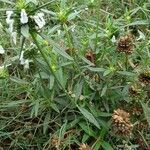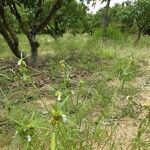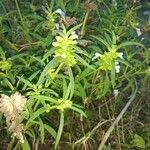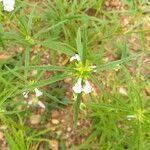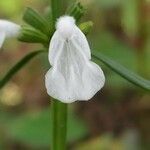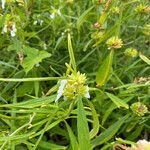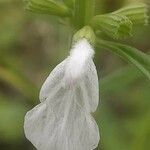| Therapeutic use
|
Anorexia (aerial part), Antiparasitic agents (aerial part), Constipation (aerial part), Anemia (flower), Anthelmintics (flower), Anti-bacterial agents (flower), Anti-inflammatory agents (flower), Antirheumatic agents (flower), Common cold (flower), Cough (flower), Digestive system diseases (flower), Exanthema (flower), Eye diseases (flower), Fever (flower), Headache (flower), Influenza, human (flower), Jaundice (flower), Malaria (flower), Menstruation disturbances (flower), Migraine disorders (flower), Nasal disease (flower), Rabies (flower), Scorpion stings (flower), Skin diseases (flower), Smallpox (flower), Snake bites (flower), Ulcer (flower), Antipyretics (fruit), Ulcer (fruit), Anthelmintics (leaf), Anti-bacterial agents (leaf), Antiemetics (leaf), Anti-infective agents, local (leaf), Anti-inflammatory agents (leaf), Antirheumatic agents (leaf), Appetite stimulants (leaf), Bites and stings (leaf), Brain diseases (leaf), Common cold (leaf), Cough (leaf), Dandruff (leaf), Dental caries (leaf), Digestive system diseases (leaf), Dysentery (leaf), Dyspepsia (leaf), Ear diseases (leaf), Edema (leaf), Disorder of ejaculation (leaf), Epistaxis (leaf), Exanthema (leaf), Eye diseases (leaf), Female urogenital diseases (leaf), Fever (leaf), Filariasis (leaf), Gonorrhea (leaf), Headache (leaf), Hemorrhoids (leaf), Hemostasis (leaf), Hepatitis (leaf), Infertility (leaf), Insecticides (leaf), Jaundice (leaf), Leprosy (leaf), Malaria (leaf), Migraine disorders (leaf), Molluscacides (leaf), Mouth diseases (leaf), Nasal disease (leaf), Pain (leaf), Increase physical endurance, strength and stamina (leaf), Psoriasis (leaf), Rabies (leaf), Respiratory tract diseases (leaf), Scabies (leaf), Scorpion stings (leaf), Sinusitis (leaf), Skin diseases (leaf), Snake bites (leaf), Stomach diseases (leaf), Tonsillitis (leaf), Urinary tract infections (leaf), Urination disorders (leaf), Wounds and injuries (leaf), Nocturnal emission of semen (leaf), Anthelmintics (root), Antirheumatic agents (root), Appetite stimulants (root), Asthma (root), Bites and stings (root), Bronchial diseases (root), Common cold (root), Cough (root), Fever (root), Headache (root), Influenza, human (root), Malaria (root), Migraine disorders (root), Nasal disease (root), Scorpion stings (root), Snake bites (root), Toothache (root), Wounds and injuries (root), Antirheumatic agents (seed), Skin diseases (seed), Sterilization, reproductive (seed), Urination disorders (seed), Antidotes (shoot), Jaundice (shoot), Paralysis (shoot), Cough (stem), Dyspepsia (stem), Fever (stem), Influenza, human (stem), Jaundice (stem), Malaria (stem), Sinusitis (stem), Urination disorders (stem), Antidote(Insect) (unspecified), Bactericide (unspecified), Bite(Snake) (unspecified), Cough (unspecified), Fever (unspecified), Psoriasis (unspecified), Skin (unspecified), Swelling (unspecified), Cold (unspecified), Amenorrhea (unspecified), Analgesics (unspecified), Anemia (unspecified), Anorexia (unspecified), Anthelmintics (unspecified), Anti-bacterial agents (unspecified), Antifungal agents (unspecified), Anti-infective agents, local (unspecified), Anti-inflammatory agents (unspecified), Antipyretics (unspecified), Antirheumatic agents (unspecified), Arthralgia (unspecified), Colic (unspecified), Common cold (unspecified), Dysmenorrhea (unspecified), Dyspepsia (unspecified), Exanthema (unspecified), Expectorants (unspecified), Eye infections (unspecified), Eye pain (unspecified), Flatulence (unspecified), Gastrointestinal diseases (unspecified), Headache (unspecified), Hepatitis (unspecified), Histamine antagonists (unspecified), Hypohidrosis (unspecified), Influenza, human (unspecified), Insect bites and stings (unspecified), Insecticides (unspecified), Jaundice (unspecified), Kidney diseases (unspecified), Laxatives (unspecified), Liver diseases (unspecified), Lung diseases (unspecified), Menstruation-inducing agents (unspecified), Musculoskeletal diseases (unspecified), Paralysis (unspecified), Rabies (unspecified), General tonic for rejuvenation (unspecified), Rickets (unspecified), Skin diseases (unspecified), Snake bites (unspecified), Ulcer (unspecified), Wound healing (unspecified), Analgesics (whole plant), Anthelmintics (whole plant), Anti-bacterial agents (whole plant), Anti-inflammatory agents (whole plant), Antioxidants (whole plant), Antipyretics (whole plant), Asthma (whole plant), Bronchitis (whole plant), Common cold (whole plant), Cough (whole plant), Diuretics (whole plant), Headache (whole plant), Insecticides (whole plant), Migraine disorders (whole plant), Nausea (whole plant), Respiratory tract diseases (whole plant), Scabies (whole plant), Wound healing (whole plant)
|
